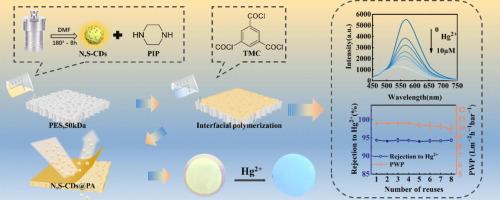N, S-CDs encapsulated polyamide fluorescent membranes: An efficient strategy for the retention and detection of mercury (II) ions in aqueous environments
IF 9
1区 工程技术
Q1 ENGINEERING, CHEMICAL
引用次数: 0
Abstract
Nanofiltration membranes are extensively implemented in water treatment, particularly for the efficient interception of toxic heavy metal ions. This work introduces a novel functional membrane fabricated via interfacial polymerization, incorporating nitrogen and sulfur co-doped carbon dots (N, S-CDs) as additives to enhance mercury removal from aqueous solutions. The integration of carbon dots has been demonstrated to significantly augment the membrane’s hydrophilicity, thereby improving the pure water flux. Moreover, it modulates the crosslinking degree of the polyamide layer, enhancing mercury retention. The N, S-CDs, due to their high selectivity for Hg (II), confer the modified membrane with fluorescence detection capabilities, allowing for the precise quantification of mercury rejection. The membrane achieved a remarkable Hg (II) retention rate of 94.85 %, with a pure water flux of 10.68 L m−2 h−1 bar−1, and attained a detection limit of 5.49 × 10−7 M for Hg (II). The durability and reusability of the membrane are substantiated by soaking and recycling trials, underscoring the stable encapsulation of N, S-CDs within the nanofiltration matrix.


N, S-CDs封装聚酰胺荧光膜:水环境中汞(II)离子的有效保留和检测策略
纳滤膜在水处理中得到了广泛的应用,特别是在有效拦截有毒重金属离子方面。本文介绍了一种通过界面聚合制备的新型功能膜,将氮和硫共掺杂碳点(N, S-CDs)作为添加剂,以增强水溶液中的汞去除。碳点的集成已被证明可以显著增强膜的亲水性,从而提高纯水通量。此外,它还能调节聚酰胺层的交联度,增强汞潴留。由于N, S-CDs对汞(II)的高选择性,使改性膜具有荧光检测能力,从而可以精确定量汞排斥。该膜的Hg (II)截留率为94.85 %,纯水通量为10.68 L m−2 h−1 bar−1,对Hg (II)的检出限为5.49 × 10−7 m。通过浸泡和回收试验证实了膜的耐久性和可重复使用性,突出了N, S-CDs在纳滤基质内的稳定包封。
本文章由计算机程序翻译,如有差异,请以英文原文为准。
求助全文
约1分钟内获得全文
求助全文
来源期刊

Separation and Purification Technology
工程技术-工程:化工
CiteScore
14.00
自引率
12.80%
发文量
2347
审稿时长
43 days
期刊介绍:
Separation and Purification Technology is a premier journal committed to sharing innovative methods for separation and purification in chemical and environmental engineering, encompassing both homogeneous solutions and heterogeneous mixtures. Our scope includes the separation and/or purification of liquids, vapors, and gases, as well as carbon capture and separation techniques. However, it's important to note that methods solely intended for analytical purposes are not within the scope of the journal. Additionally, disciplines such as soil science, polymer science, and metallurgy fall outside the purview of Separation and Purification Technology. Join us in advancing the field of separation and purification methods for sustainable solutions in chemical and environmental engineering.
文献相关原料
公司名称
产品信息
阿拉丁
3-mercaptopropionic acid (3-MPA)
阿拉丁
potassium hydroxide
阿拉丁
tribenzoyl chloride (TMC)
阿拉丁
<em>n</em>-hexane
阿拉丁
3-mertopropionic acid
阿拉丁
Potassium hydroxide
阿拉丁
Tribenzoyl chloride
阿拉丁
n-hexane
阿拉丁
3-mercaptopropionic acid (3-MPA)
阿拉丁
potassium hydroxide
阿拉丁
tribenzoyl chloride (TMC)
阿拉丁
n-hexane
 求助内容:
求助内容: 应助结果提醒方式:
应助结果提醒方式:


